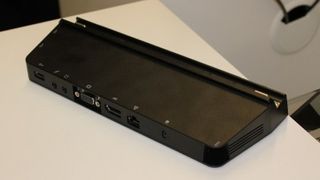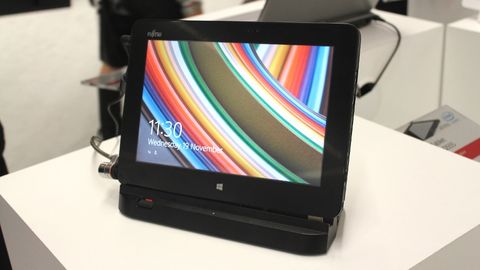Early Verdict
Light and portable business tablet should appeal to the mobile professionals requiring high levels of connectivity and security on the go, but it isn't the cheapest around.
Pros
- +
Light
- +
Fanless
- +
Full-HD display
- +
Connectivity and security options
Cons
- -
Max 128GB storage
- -
No battery in keyboard
- -
Quite pricey
Why you can trust TechRadar
The Stylistic Q555 is the latest business tablet from Fujitsu. Launched at the Fujitsu Forum in Munich, the 10.1-inch Windows 8.1 convertible is an evolution of the Stylistic Q572 that was outed in 2013.
The Japanese IT services giant is targeting business users and government employees with the device, which can be configured with a number of security options - from smart card readers to fingerprint scanners or encrypted SSDs. It also comes a stylus (housed in the keyboard), which can be used for taking notes and tapping on the display.
In a similar fashion to 2-in-1s such as Surface Pro 3 and Dell's Venue 11 Pro 7140, the Q555 can offer a desktop-like experience when connected to its keyboard or cradle accessory. While it could, in theory, replace your laptop or desktop PC, the inclusion of an Intel Atom-based CPU means that the Q555 is better positioned as a secondary device to be used away from a main, more powerful machine.
The Q555 starts at £899 (around $1,406 or AUS$1,626) for the base model with 64GB of SSD storage and is also available with a 128GB SSD.

Light and sleek
The Q555 is a sleek offering clad in black plastic with a patterned rubber texture on the rear for grip. It features a typically understated design for a business tablet, which is neither exciting nor boring, lying somewhere in the middle. At 600 grams it's certainly light, coming in at 200 grams lighter than the Surface Pro 3.
One of the biggest drawbacks of the Stylistic Q572 was its low pixel-resolution display, which topped out at 1366 x 768. Fujitsu has rectified that by equipping the Q555 with a bright and vibrant anti-glare panel with good viewing angles, which has a pixel-resolution of 1920 x 1200 (or WUXGA, if you're into your acronyms).
Rather than the Surface Pro 3's unconventional 3:2 aspect ratio or the iPad's 4:3, that makes the Q555's display plain old 16:10, which many people like because it provides extra vertical height (over conventional 16:9) when snapping documents side-by-side and undertaking other tasks on the desktop.

Mover and shaker
The Q555 is being pitched as a secondary device designed to be used on the go, rather than a desktop-based powerhouse. It houses a 64-bit Intel Atom BayTrail-T CPU, a quad-core chip with a 2MB cache clocked to 2.4GHz backed up by 4GB of RAM.
It felt responsive and nippy enough on the desktop, switching and opening Windows apps within seconds, but those hungry for more power will need to seek out something along the lines of Fujitsu's Stylistic Q702, another recently launched tablet that comes with Intel's Core-series processors.
On the other hand, opting for an Atom CPU brings the Q555 particular benefits related to mobility. According to a Fujitsu spokesperson who demoed the unit on the show floor, Fujitsu switched from an AMD CPU in the Q572 to an Intel Atom variant in the Q555 for two reasons: customers apparently requested Intel over AMD, and it also allowed Fujitsu to make the device fanless.
As such, the Q555 is near silent in operation and runs incredibly cool in the hand. Additionally, the company claims that the device's battery can go for up to 10 hours without giving up the ghost.

Accessories
The Q555 locks into its keyboard accessory pretty easily. Once lined up, it clicks into place in one swift motion and is rock solid when attached. The hinge on the other hand isn't particularly sturdy; it doesn't slip out of position but wobbles up and down to quite a degree after being moved.
At the back of the keyboard is an extendible heel that can be pulled out to help it balance when used on a flat surface. The keyboard itself features full-sized chiclet-spaced keys that are adequately sized and much more comfortable than small keys you would find on smaller convertibles such as the Asus T100.
You'll find plenty of interfaces on the Q555, including one USB 2.0 and one USB 3.0 port, SIM or microSIM slots (if configured for use with a 4G LTE network), a memory card slot, optional SmartCard slot, two internal microphones, audio in and out, a docking connector, power port and a Kensington lock slot.
Additionally, twinning it with the cradle dock can extend the number of ports available to add VGA, LAN and HDMI for hooking up to an external monitor. It also adds another pair of USB 3.0 ports.

Verdict
The Q555 doesn't possess the most exciting design you can find on a tablet, but it's highly configurable and engineered for practicality. Its attractive screen has a healthy pixel count, and there's enough power under the hood for every day tasks. The option of a microSIM slot takes care of connectivity needs for business road warriors, potentially removing the need to carry a separate tablet and laptop.
On the negative side, its cost could be considered a little steep for just 64GB of SSD storage, and the price will ramp up once accessories are added on, which are essential to the experience. For some, the Q555 may also prove a little too pedestrian in terms of accessories, lacking any battery-boosting add-ons such as the HP ElitePad 1000 G2's innovative Power Jackets.
What is a hands on review?
Hands on reviews' are a journalist's first impressions of a piece of kit based on spending some time with it. It may be just a few moments, or a few hours. The important thing is we have been able to play with it ourselves and can give you some sense of what it's like to use, even if it's only an embryonic view. For more information, see TechRadar's Reviews Guarantee.


